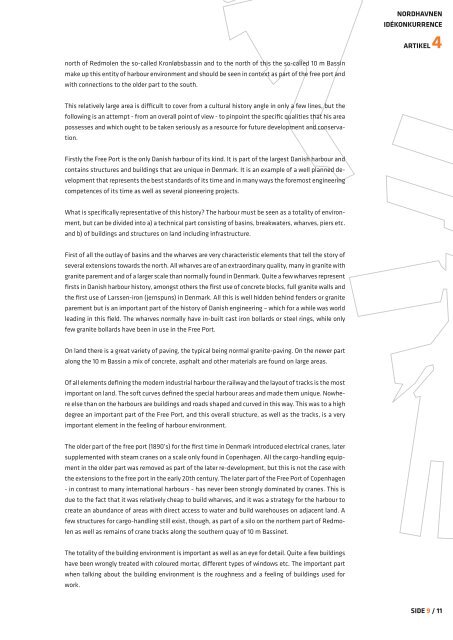PDF artikelsamling - Nordhavnen
PDF artikelsamling - Nordhavnen
PDF artikelsamling - Nordhavnen
You also want an ePaper? Increase the reach of your titles
YUMPU automatically turns print PDFs into web optimized ePapers that Google loves.
north of Redmolen the so-called Kronløbsbassin and to the north of this the so-called 10 m Bassin<br />
make up this entity of harbour environment and should be seen in context as part of the free port and<br />
with connections to the older part to the south.<br />
This relatively large area is difficult to cover from a cultural history angle in only a few lines, but the<br />
following is an attempt - from an overall point of view - to pinpoint the specific qualities that his area<br />
possesses and which ought to be taken seriously as a resource for future development and conservation.<br />
Firstly the Free Port is the only Danish harbour of its kind. It is part of the largest Danish harbour and<br />
contains structures and buildings that are unique in Denmark. It is an example of a well planned development<br />
that represents the best standards of its time and in many ways the foremost engineering<br />
competences of its time as well as several pioneering projects.<br />
What is specifically representative of this history? The harbour must be seen as a totality of environ-<br />
ment, but can be divided into a) a technical part consisting of basins, breakwaters, wharves, piers etc.<br />
and b) of buildings and structures on land including infrastructure.<br />
First of all the outlay of basins and the wharves are very characteristic elements that tell the story of<br />
several extensions towards the north. All wharves are of an extraordinary quality, many in granite with<br />
granite parement and of a larger scale than normally found in Denmark. Quite a few wharves represent<br />
firsts in Danish harbour history, amongst others the first use of concrete blocks, full granite walls and<br />
the first use of Larssen-iron (jernspuns) in Denmark. All this is well hidden behind fenders or granite<br />
parement but is an important part of the history of Danish engineering – which for a while was world<br />
leading in this field. The wharves normally have in-built cast iron bollards or steel rings, while only<br />
few granite bollards have been in use in the Free Port.<br />
On land there is a great variety of paving, the typical being normal granite-paving. On the newer part<br />
along the 10 m Bassin a mix of concrete, asphalt and other materials are found on large areas.<br />
Of all elements defining the modern industrial harbour the railway and the layout of tracks is the most<br />
important on land. The soft curves defined the special harbour areas and made them unique. Nowhere<br />
else than on the harbours are buildings and roads shaped and curved in this way. This was to a high<br />
degree an important part of the Free Port, and this overall structure, as well as the tracks, is a very<br />
important element in the feeling of harbour environment.<br />
The older part of the free port (1890’s) for the first time in Denmark introduced electrical cranes, later<br />
supplemented with steam cranes on a scale only found in Copenhagen. All the cargo-handling equipment<br />
in the older part was removed as part of the later re-development, but this is not the case with<br />
the extensions to the free port in the early 20th century. The later part of the Free Port of Copenhagen<br />
- in contrast to many international harbours - has never been strongly dominated by cranes. This is<br />
due to the fact that it was relatively cheap to build wharves, and it was a strategy for the harbour to<br />
create an abundance of areas with direct access to water and build warehouses on adjacent land. A<br />
few structures for cargo-handling still exist, though, as part of a silo on the northern part of Redmolen<br />
as well as remains of crane tracks along the southern quay of 10 m Bassinet.<br />
The totality of the building environment is important as well as an eye for detail. Quite a few buildings<br />
have been wrongly treated with coloured mortar, different types of windows etc. The important part<br />
when talking about the building environment is the roughness and a feeling of buildings used for<br />
work.<br />
NOrdhavNEN<br />
idéKONKurrENcE<br />
arTiKEL 4<br />
sidE 9 / 11


